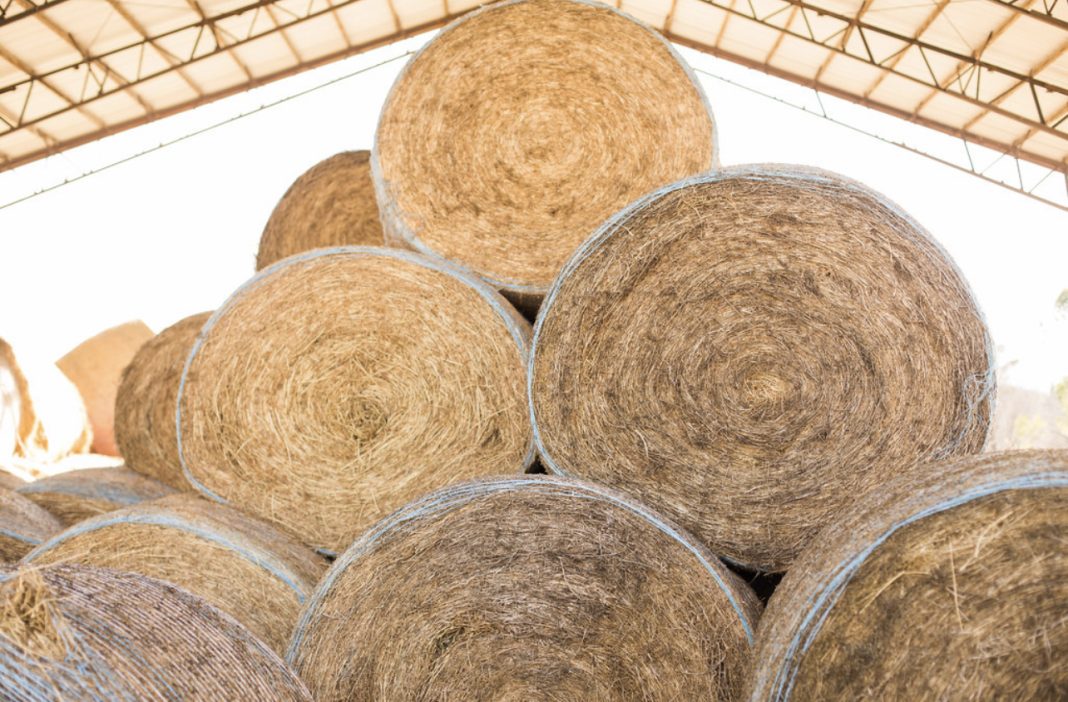Drought and high fertilizer prices took a significant bite out of hay production across the U.S. Extension Economist James Mitchell expects farmers will pay more for hay in the current marketing year. (U of A System Division of Agriculture file photo by Lauren Husband)
By Mary Hightower
U of A System Division of Agriculture
High fertilizer prices and drought in 2022 handed hay production in the United States its biggest decline in 11 years with stocks at their lowest level since data collection began, according to the National Agricultural Statistics Service.
The stats were part of the Jan. 12 Crop Production Summary from NASS, which is part of the U.S. Department of Agriculture. The report includes information about all U.S. crops, their production, acreage, and yield. NASS places hay in two categories, alfalfa and “other hay,” the latter being relevant to the Southeastern U.S.
Drought and high fertilizer prices took a significant bite out of hay production across the U.S. Extension Economist James Mitchell expects farmers will pay more for hay in the current marketing year. (U of A System Division of Agriculture file photo by Lauren Husband)
According to the summary, May 1 hay stocks were tight, totaling 16.77 million tons or 7 percent lower year over year.
“May 1 stocks, combined with lower 2022 hay production, put hay supplies at the lowest level on record since the data began in 1974,” said James Mitchell, extension economist for the University of Arkansas System Division of Agriculture. “The previous record low in hay supplies was in 2021.”
Production declines
Nationwide, other hay production totaled 64.84 million tons in 2022, down 9 percent from the prior year, with Arkansas seeing a 16 percent decline. Texas, the nation’s largest hay-producing state, produced 6.15 million tons, a 40 percent decline compared to 2021.
“Most Southern Plains and Southeast states had double-digit hay production declines,” said Mitchell said.
Mississippi saw a 16 percent decline, Tennessee a 13 percent decline, and Kentucky, a 20 percent decline. Florida bucked the trend, seeing a 7 percent increase in hay production.
“USDA’s estimate for Arkansas is much better than what I would have predicted last summer,” Mitchell said. Based on conversations with producers last year, he said “I was expecting a decline closer to 25 percent.
“It was hard to predict whether we would get late-season rain last summer,” Mitchell said. “It was even hard to predict whether a late-season rain would help us make up for the severe production losses we had in July. Conditions improved enough in September for us to make up for some of that loss.”
Yields down
“Expensive fertilizer and poor precipitation impacted yields,” he said. “U.S. hay yields averaged 1.87 tons per acre or 6 percent lower year over year. Yields dropped 9 percent in Arkansas to two tons per acre. Neighboring Oklahoma and Texas saw yields averaging 1.25 tons per acre and 1.50 tons per acre, respectively.”
Overall, other hay acreage fell 2 percent to 34.63 acres. Arkansas’ hay acres declined by 5 percent, while Texas saw a 25 percent reduction in hay acres in 2022.
Mitchell said that “declining cattle inventories, expensive inputs, and high crop prices all likely contributed to the decline in 2022 hay acreage.”
Higher prices
Mitchell said farmer would likely be paying more for hay.
“Like other commodities, price comparisons are based on the marketing year,” he said. The hay marketing year begins in May and ends in April.
“For the May 2021-April 2022 marketing year, prices averaged $147 per ton,” Mitchell said. “For the May 2022-April 2023 marketing year, we forecast prices to average $170 per ton.”
To learn about extension programs in Arkansas, contact your local Cooperative Extension Service agent or visit www.uaex.uada.edu. Follow us on Twitter and Instagram at @AR_Extension. To learn more about Division of Agriculture research, visit the Arkansas Agricultural Experiment Station website: https://aaes.uada.edu. Follow on Twitter at @ArkAgResearch. To learn more about the Division of Agriculture, visit https://uada.edu/. Follow us on Twitter at @AgInArk.
About the Division of Agriculture
The University of Arkansas System Division of Agriculture’s mission is to strengthen agriculture, communities, and families by connecting trusted research to the adoption of best practices. Through the Agricultural Experiment Station and the Cooperative Extension Service, the Division of Agriculture conducts research and extension work within the nation’s historic land grant education system.
The Division of Agriculture is one of 20 entities within the University of Arkansas System. It has offices in all 75 counties in Arkansas and faculty on five system campuses.
The University of Arkansas System Division of Agriculture offers all its Extension and Research programs and services without regard to race, color, sex, gender identity, sexual orientation, national origin, religion, age, disability, marital or veteran status, genetic information, or any other legally protected status, and is an Affirmative Action/Equal Opportunity Employer.







